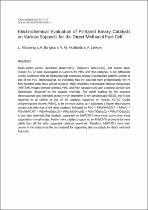 ResearchSpace
ResearchSpace
Electrochemical evaluation of Pt-Based binary catalysts on various supports for the direct methanol fuel cell
JavaScript is disabled for your browser. Some features of this site may not work without it.
- ResearchSpace
- →
- Research Publications/Outputs
- →
- Journal Articles
- →
- View Item
| dc.contributor.author |
Khotseng, L

|
|
| dc.contributor.author |
Bangisa, A

|
|
| dc.contributor.author |
Modibedi, Remegia M

|
|
| dc.contributor.author |
Linkov, V

|
|
| dc.date.accessioned | 2016-07-20T11:01:21Z | |
| dc.date.available | 2016-07-20T11:01:21Z | |
| dc.date.issued | 2016-01 | |
| dc.identifier.citation | Khotseng, L. Bangisa, A. Modibedi, R.M. and Linkov, V. 2016. Electrochemical evaluation of Pt-Based binary catalysts on various supports for the direct methanol fuel cell. Electrocatalysis, 7(1), 1-11 | en_US |
| dc.identifier.issn | 1868-2529 | |
| dc.identifier.uri | http://link.springer.com/article/10.1007%2Fs12678-015-0282-x | |
| dc.identifier.uri | http://hdl.handle.net/10204/8655 | |
| dc.description | Copyright: 2015 Springer. Due to copyright restrictions, the attached PDF file only contains the abstract of the full text item. For access to the full text item, please consult the publisher's website. The definitive version of the work is published in Electrocatalysis, 7(1), 1-11 | en_US |
| dc.description.abstract | Multi-walled carbon nanotubes (MWCNTs), TiO(sub2), MoO(sub2), and carbon black Vulcan XC-72 were investigated as supports for PtRu and PtSn catalysts. X-ray diffraction (XRD) confirmed that all electrocatalysts examined display characteristic patterns similar to that of the Pt/C electrocatalyst, an indication that the catalysts have predominantly the Pt face-centered cubic (fcc) crystal structure. High-resolution transmission electron microscopy (HRTEM) images showed spherical PtRu and PtSn nanoparticles with a narrow particle size distribution, dispersed on the support materials. The metal loading for the prepared electrocatalyst was estimated using energy-dispersive X-ray spectroscopy (EDS), and it was observed to be closest to that of the catalysts supported on Vulcan XC-72. Cyclic voltammograms showed PtSn/C to be the most active, as it possessed a higher electroactive surface area than that of the other catalysts, followed by Pt/C > PtRu/MWCNT > PtRu/C > PtSn/MWCNT > PtSn/MoO(sub2) > PtRu/MoO(sub2) > PtSn/TiO(sub2) > PtRu/TiO(sub2). It was also observed that catalysts supported on MWCNTs were more active than those supported on metal oxides. Furthermore, catalysts supported on MWCNTs proved to be more stable than all the other supported catalysts examined. Therefore, MWCNTs have been proven in this study to be the best material for supporting electrocatalysts for direct methanol fuel cells. | en_US |
| dc.language.iso | en | en_US |
| dc.publisher | Springer | en_US |
| dc.relation.ispartofseries | Workflow;17096 | |
| dc.subject | Direct methanol fuel cells | en_US |
| dc.subject | Multi walled carbon nanotubes | en_US |
| dc.subject | Metal oxides | en_US |
| dc.subject | Pt-based binary catalysts | en_US |
| dc.title | Electrochemical evaluation of Pt-Based binary catalysts on various supports for the direct methanol fuel cell | en_US |
| dc.type | Article | en_US |
| dc.identifier.apacitation | Khotseng, L., Bangisa, A., Modibedi, R. M., & Linkov, V. (2016). Electrochemical evaluation of Pt-Based binary catalysts on various supports for the direct methanol fuel cell. http://hdl.handle.net/10204/8655 | en_ZA |
| dc.identifier.chicagocitation | Khotseng, L, A Bangisa, Remegia M Modibedi, and V Linkov "Electrochemical evaluation of Pt-Based binary catalysts on various supports for the direct methanol fuel cell." (2016) http://hdl.handle.net/10204/8655 | en_ZA |
| dc.identifier.vancouvercitation | Khotseng L, Bangisa A, Modibedi RM, Linkov V. Electrochemical evaluation of Pt-Based binary catalysts on various supports for the direct methanol fuel cell. 2016; http://hdl.handle.net/10204/8655. | en_ZA |
| dc.identifier.ris | TY - Article AU - Khotseng, L AU - Bangisa, A AU - Modibedi, Remegia M AU - Linkov, V AB - Multi-walled carbon nanotubes (MWCNTs), TiO(sub2), MoO(sub2), and carbon black Vulcan XC-72 were investigated as supports for PtRu and PtSn catalysts. X-ray diffraction (XRD) confirmed that all electrocatalysts examined display characteristic patterns similar to that of the Pt/C electrocatalyst, an indication that the catalysts have predominantly the Pt face-centered cubic (fcc) crystal structure. High-resolution transmission electron microscopy (HRTEM) images showed spherical PtRu and PtSn nanoparticles with a narrow particle size distribution, dispersed on the support materials. The metal loading for the prepared electrocatalyst was estimated using energy-dispersive X-ray spectroscopy (EDS), and it was observed to be closest to that of the catalysts supported on Vulcan XC-72. Cyclic voltammograms showed PtSn/C to be the most active, as it possessed a higher electroactive surface area than that of the other catalysts, followed by Pt/C > PtRu/MWCNT > PtRu/C > PtSn/MWCNT > PtSn/MoO(sub2) > PtRu/MoO(sub2) > PtSn/TiO(sub2) > PtRu/TiO(sub2). It was also observed that catalysts supported on MWCNTs were more active than those supported on metal oxides. Furthermore, catalysts supported on MWCNTs proved to be more stable than all the other supported catalysts examined. Therefore, MWCNTs have been proven in this study to be the best material for supporting electrocatalysts for direct methanol fuel cells. DA - 2016-01 DB - ResearchSpace DP - CSIR KW - Direct methanol fuel cells KW - Multi walled carbon nanotubes KW - Metal oxides KW - Pt-based binary catalysts LK - https://researchspace.csir.co.za PY - 2016 SM - 1868-2529 T1 - Electrochemical evaluation of Pt-Based binary catalysts on various supports for the direct methanol fuel cell TI - Electrochemical evaluation of Pt-Based binary catalysts on various supports for the direct methanol fuel cell UR - http://hdl.handle.net/10204/8655 ER - | en_ZA |





